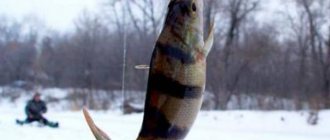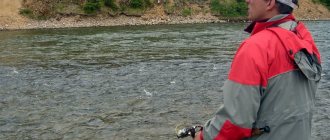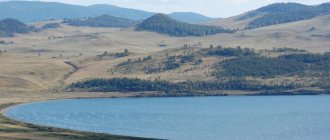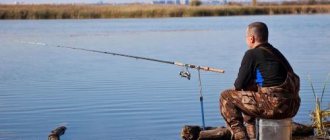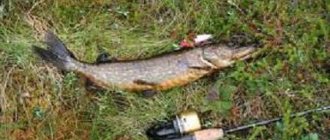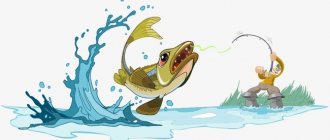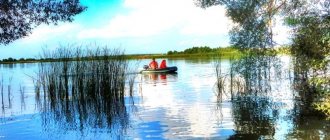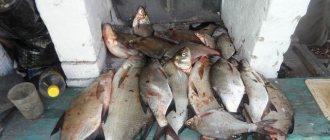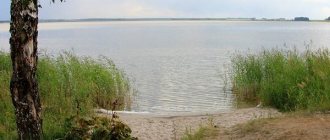Rivers
Rivers of the Tomsk region, which are in demand among fishermen.
Chulym River
Chulym is the right tributary of the Ob. The most interesting fishing on the river begins with the arrival of the autumn months. At this time, anglers hunt for trophy pike perch and pike.
Chulym River
Pike on this river are better caught with large rotating and oscillating spoons. Pike perch on Chulym can be caught with both classic jig baits and sinking wobblers of natural colors.
Pike can be successfully caught from the shore, but pike perch will require a boat.
Tom River
Most Tomsk fishermen prefer not to go fishing far beyond the city limits and fish on the Tom River, which flows within Tomsk. Fishing in Tomsk can bring a good catch both during open water and during freeze-up.
Tom River
The waters of the Tom River are home to a variety of fish species, but fishermen's trophies most often include: chebak, crucian carp, dace, Siberian tench, ruff, ide, perch, pike perch, pike, burbot.
River Ob
The Ob is distinguished by a huge number of tributaries, where a wide variety of fish live. Every year tourists from all over Russia come to the river.
In the Tomsk region, fishing on the Ob is most popular in winter, when the river is covered with a strong layer of ice. For ice fishing, it is recommended to use a bottom fishing rod, and the bait is selected depending on the type of fish: pike bites on fry, roach on maggots, crucian carp on bloodworms or worms.
Fishing on the lakes of the Tomsk region with a balance beam in winter
01/07/2015 admin Leave a comment
There are few people in Siberia who truly love winter; many are forced to wait for it in order to do some things that cannot be done in the summer. But the cunning ice fishermen are always waiting for her. I often remember such a real fisherman from my childhood - grandfather Karkunov from the village of Yaya in the Kemerovo region, he was already nearly 90 years old in the late eighties. A former front-line soldier (whole chest is covered in orders and medals), no matter how cold and windy it is outside in winter, rides a Ural motorcycle alone to the Tomsk region for fishing in his favorite places (lakes, oxbow lakes, rivers) near the village. Okunevo, Mazalovo village. He was a real man who experienced all the hardships and hardships of the war, who, despite his advanced age, did not consider this way of getting to fishing difficult. For this reason, he dressed very warmly, and fastened the sheepskin coat at the back.
Everyone knows that in Siberia there are severe frosts in winter, due to which the ice reaches a thickness of more than a meter by the end of January. Therefore, Siberians try to make the most of the first two months of winter. We especially look forward to the first ice, because at this time drilling a hole or punching it with an ax in 3-4 blows is not difficult. On the first ice, here in the Tomsk region , many people express a desire to fish with artificial bait. For example, I prefer balancers. There will still be plenty of time for bait in the second half of winter, but now you need to rush to fish with an “ice spinning rod” - this is what a fishing rod for vertical fishing from the ice is sometimes called.
Why exactly the balancer and specifically on the first ice? Because this bait is very well suited for active fishing. With it you can quickly fish large areas of the reservoir. In my opinion, the balancer attracts fish from a greater distance than, for example, spoons (on lakes with a flat bottom - according to my estimates, 6-10 m), and in this case you will have to drill fewer holes - and this is the speed of finding fish and , as a result, a larger catch. And the game of the balancer itself, and more specifically, its wide range of movements is best suited for finding active fish. Of course, it is not always possible for a bait with a sweeping action to catch all the fish located under the hole.
The main thing is to go out, and finding fish is already half the battle. And then you can change the pace of the game, and put a smaller bait, if you have the desire and patience, and luck will come. Active search for fish is especially in demand on the lakes of the Tomsk region - “saucers”, where there are no wintering sites for fish. And there are plenty of similar lakes and rivers in the taiga, and there is a “sea” of fish in them. Sometimes, it is not even necessary for a fish to be caught - it is enough to detect its presence by feeling a poke on the balancer. Such a sluggish bite eloquently indicates that there is fish under the hole, which means you can linger and look for a suitable game or bait.
The first ice does not always live up to expectations. On most lakes, the first two or three days with the appearance of hardened ice, fishing is not good. Apparently, she is getting used to the new conditions of existence. There are lakes where it is worth waiting a couple of weeks for the opening of the closed water season after ice formation. At the same time, there are many reservoirs where, on the contrary, fish will bite only for the first one or two weeks, and then will only be active during the last spring ice.
And on some bodies of water, fish are almost always active, and on the first ice, of course, too. Usually these are reservoirs with a good food supply and oxygen regime. Even in the dead of winter there is a bite for them. We also have local specifics. As you know, the depths of Siberia are rich in oil and gas, and on some lakes, gas is released into the water every 5-10 years, which is why the fish naturally refuse to bite.
One day we came to a fishing lake, where last year we caught great pike and perch using balance beams and girders, but only caught a few fry. However, the memories of last year's fishing were so pleasant that a couple of weeks later we went there again - and again failed. On the way back, we asked local residents and learned about the gas release. And in a situation of “gas attack,” the fish either loses activity or goes astray to the gushing springs at the bottom of the lake. Anyone who knows such places comes with a catch.
To successfully fish on the first ice, you need to know the characteristics of reservoirs. And here we can’t help but remember the famous fishing pun: “Among the places where there are fish, there are places where fish eat!” Moreover, there is a considerable difference between the fish’s bites and its eating. Guessing the time of zhora is very rare. It seems like you come for fishing year after year at the same time, on the same lake - and the weather is almost the same, and other conditions are no different from last year, but then you got caught in a gorge, and this year missed. This means that this time the fish is missing something. How can one not remember the phases of the moon, pressure and other factors...
One day we hit the first transparent ice, literally everything was visible under it. You walk along it and feel almost like Jesus. But then the fish didn’t bite at all. And only on the windward side of the lake, where a strip of snow 3-5 m wide had drifted, was it possible to find biting fish. Apparently she felt safer there. It is not often possible to get to zhor, at best several times during the winter. Most often, ordinary labor fishing occurs, when you first need to find the fish, and then select a suitable bait for it.
Theoretically speaking, on the first ice, predatory fish have all the conditions for a good bite. There is enough oxygen in the water. The forage fish are also still active, which means you need to chase them. Therefore, the predator is in good shape and moves a lot around the reservoir. In the middle of winter, everything will be different - the pike stands in one place almost all the time. Very often, even after leaving the hook, it does not swim far. Knowing this feature, I always return to the same hole after 15-20 minutes and almost always catch the runaway. In the middle of winter, the fish saves energy. By the way, another fact speaks about this: girders catch more fish than nets.
Poachers know this feature, and on water bodies in winter you will more often see dozens of girders than dozens of nets. I don’t know whether to rejoice at this fact or not. But at least this is positive because nets frozen in the ice do not remain in the reservoir, which can kill a lot of fish in the spring. It is necessary to take into account that in the first ice the aquatic vegetation has not yet died off, and if you saw the lake in the summer, remember where the border of grass and clean water was, where there were “windows” in the grass, other nuances - all this will be useful when searching for fish. Most often, fish stay on the first ice at shallow depths - near the shore and on coastal dumps. Here at the beginning of winter there is still a lot of food, and the fish have something to profit from.
In the middle of winter, it is still possible to quite clearly divide the behavior of fish into periods of passivity and activity during the day. For example, a pike can come out to feed in the morning, say, from 9 to 11 o’clock - and that’s it, then wait for the evening bite, if, of course, it happens. On the first ice, the fish are approximately equally active all day.
In November and December, the days are very short, so you need to get on the ice at dawn and, without wasting time, start looking for fish. It is best to start fishing from a coastal dump. It is important not to stay too long in one area or even on one lake. And if after a couple of hours of fishing there are no bites, then, if possible, change the reservoir. I have already mentioned that on one lake there may not be a bite (for example, due to a gas release), but on a neighboring lake the situation may be completely different.
The technique of fishing with a balancer is selected to quickly find fish. This is usually 10 quick swings and short pauses and then 10 swings with a longer pause. If there is no bite, feel free to move to another hole. If the place seemed promising, and even more so if there were bites, then after half an hour you can fish all the drilled holes again. How often should the balancer be changed? If you catch fish , then there is no point in changing the bait, but if the bite is sluggish, then it’s worth experimenting - for example, changing the balancers every time you fish the holes.
In general, determining the strategy and tactics of fishing and adhering to the chosen pattern is a very important component of fishing, and even more so when fishing with balance beams in winter. There is no point in haphazardly drilling through ice on a body of water. Strategically, the task consists of several main issues. Are you looking for fish individually or in a group? Do you choose tempo fishing or careful leisurely fishing of a well-known place with different baits? Well, and so on. Tactical tasks already concern the nuances of finding fish, fishing techniques, etc.
For some reason, beginners often think that it is easier to catch a perch using bloodworms or maggots than using a spoon or a balance beam. In my opinion, this is not the case. Perch is a schooling predator, and as soon as you find a school and get at least one fish to bite, the bites begin one after another. Food competition causes bass to compete with each other.
At the same time, it is unlikely that you will be able to catch more perch in the same amount of time with a jig than with a balance beam, especially during the feeding period. Often you don’t even need to play with a balancer - the perch is so “hot” that you just need to lower the bait to the desired horizon, and he immediately grabs it. Of course, sometimes the jig catches the balancer, but this happens either when catching small perch, or on the worst days for fishing, when the perch prefers small baits.
The choice of balancer is carried out according to three characteristics - size, play and color, in that order. The size of the bait determines both the number of bites and the size of the fish caught. Next, the design and, as a result, the game are important. It is advisable to test new baits in the bathroom before fishing. If the game differs from the usual one, then this must be remembered or written down in a special notebook. For some baits, the pause between swings of the fishing rod needs to be longer, for others - shorter, etc.
The colors of balancers can be divided into natural and provocative. To catch pike, we select a larger balancer - from 6-7 cm. I often use lures 9 cm long. The larger the balancer, the wider its horizontal amplitude, which means it fishes a larger area, and this is also an important plus for tempo fishing. Pike balancers should be equipped with fairly large hooks. Some models have two single hook options in the same size. For pike, naturally, larger hooks are preferred.
Most often , pike grab the bait across, so the size of the tee is critical. With large gatherings, and there are much fewer empty bites. Instead of a standard tee, you can put 1-2 numbers larger. The size of the tee is selected according to a simple principle: the hooks of its sting should not cling to the body of the bait. During the game, an excessively large tee will swing and often cling to the bait or leash. If this happens, then the bait must be lowered into the hole as carefully as possible (often it is when lowering that the tee hooks) and play with it without sudden jerks.
Since at the beginning of winter the fish usually stay at shallow depths and near the shore, we play with the balancer mainly near the bottom. And in general, at depths less than 1.5-2 m, there is no point in trying to play under the ice. At more substantial depths, starting from 3 m, it is advisable to also check the middle and upper horizons. For a novice angler, fishing with winter lures, in particular with a balancer, may at first seem more difficult than with a spinning rod - there is no such clarity as in the summer, there is only white snow and ice all around. This is where you can prove to a beginner both the catchability of the bait and the readability of the situation under the ice with the personal example of an experienced spinner. Fishing in winter is no worse than in summer, and the catches are often large.
These articles may interest you
- About catching perch in the wilderness
- How to assemble a winter fishing rod correctly
- Homemade fishing rod for trolling from a telescopic spinning rod
- Winter fishing without change on the Gilevsky Reservoir
- Fishing spinners
- Winter jig fishing on the rivers of the Leningrad region
- Fishing in the region: Tomsk region
- Fishing in seasons: winter
- Fishing: from ice
- Articles about fishing
Add a comment Cancel reply
You must be logged in to post a comment.
Recent Entries
- Fishing with dragnet
- Making Carolina rigs for pike and perch fishing
- How to equip a Volzhanka 46 Fish boat for fishing
- Winter fishing in Finland, what and how
- About setting up the jig when assembling winter tackle
- Fishing on the Tura River in winter in February
- The A-elita vent is visible from afar
- Winter lure “A-Elita” is the best of all
- How to attach a float rig to a fishing rod?
- Installation of float equipment for fly and plug fishing rods
Advanced site search
Group 1 below in site entries
Lakes
Review of popular lakes suitable for fishing.
Lake Mirnoe
The lake is located in the Parabelsky district, 40 km northwest of the village of Pudino, among the swamps between the Chuzik and Chizhapka rivers. Around the lake are the wetlands of Vasyugan.
Lake Mirnoe
Mirnoye is famous for its fishing: people come here for ide, bream, burbot, pike perch, roach, as well as whitefish and ripus, which are rare for this region. There are places for fishermen on the shore of the lake.
Lake Sandy
The lake is located 10 km from Tomsk, near the village of Timiryazevo. Sandy is one of the first places that comes to mind when Tomsk residents choose a place to relax.
Lake Sandy
The lake and the area next to it are classified as specially protected. This means that in this place you need to take care of nature.
Lake Chertany
The “pearl” of the Pervomaisky district is Malye and Bolshie Chertany. The lakes are located approximately 200 kilometers from Tomsk.
Neptune's festival and fishing competitions are held on the lake. And individual fishermen often come here alone. No one leaves without a catch.
Lake Chertany
To Malyye Chertan 195 km from Tomsk, from Asino along the road straight to Ulu-Yul, from 11 km of the road to the right 1 km.
Fishing in neighboring regions: Kemerovo and Novosibirsk regions.
Bite forecast
White amur
0
There is no bite for grass carp. Grass carp are found in deep places.
0
There is no bite for grass carp. Grass carp are found in deep places.
0
There is no bite for grass carp. Grass carp are found in deep places.
0
There is no bite for grass carp. Grass carp are found in deep places.
0
There is no bite for grass carp. Grass carp are found in deep places.
0
There is no bite for grass carp. Grass carp are found in deep places.
0
There is no bite for grass carp. Grass carp are found in deep places.
0
There is no bite for grass carp. Grass carp are found in deep places.
0
There is no bite for grass carp. Grass carp are found in deep places.
0
There is no bite for grass carp. Grass carp are found in deep places.
0
There is no bite for grass carp. Grass carp are found in deep places.
0
There is no bite for grass carp. Grass carp are found in deep places.
0
There is no bite for grass carp. Grass carp are found in deep places.
0
There is no bite for grass carp. Grass carp are found in deep places.
0
There is no bite for grass carp. Grass carp are found in deep places.
0
There is no bite for grass carp. Grass carp are found in deep places.
Minnow
19
No minnow biting Minnow is found in deep places
28
There is almost no minnow bite. The minnow is found in deep places.
59
Average minnow bite The minnow is found in deep places
36
Sluggish minnow bite The minnow is found in deep places
20
No minnow biting Minnow is found in deep places
39
Sluggish minnow bite The minnow is found in deep places
67
Good bite for minnows Minnows are found in deep places
56
Average minnow bite The minnow is found in deep places
42
The minnow bite is worse than average. The minnow is found in deep places.
72
Good minnow bite Minnow is found in deep places
93
Excellent bite for minnows. Minnows are found in deep places.
84
Very good minnow bite The minnow is found in deep places
60
Average minnow bite The minnow is found in deep places
85
Very good minnow bite The minnow is found in deep places
73
Good minnow bite Minnow is found in deep places
61
Good bite for minnows Minnows are found in deep places
Dace
42
The dace bite is worse than average. The dace is found in deep places.
42
The dace bite is worse than average. The dace is found in deep places.
54
Average bite for dace Dace is found in deep places
38
Sluggish dace bite Dace is found in deep places
30
There is almost no dace bite. Dace is found in deep places
42
The dace bite is worse than average. The dace is found in deep places.
60
Average bite for dace Dace is found in deep places
60
Average bite for dace Dace is found in deep places
64
Good bite for dace. Dace is found in deep places.
77
Good bite for dace Dace is found in deep places
83
Very good bite for dace. Dace is found in deep places.
89
Very good bite for dace. Dace is found in deep places.
91
Excellent bite for dace Dace is found in deep places
91
Excellent bite for dace Dace is found in deep places
65
Good bite for dace. Dace is found in deep places.
65
Good bite for dace. Dace is found in deep places.
crucian carp
20
There is no bite for crucian carp. Crucian carp is in deep places.
26
There is almost no bite for crucian carp. Crucian carp is found in deep places.
36
Sluggish bite of crucian carp Crucian carp is found in deep places
24
There is almost no bite for crucian carp. Crucian carp is found in deep places.
13
There is no bite for crucian carp. Crucian carp is in deep places.
21
There is almost no bite for crucian carp. Crucian carp is found in deep places.
33
Sluggish bite of crucian carp Crucian carp is found in deep places
33
Sluggish bite of crucian carp Crucian carp is found in deep places
25
There is almost no bite for crucian carp. Crucian carp is found in deep places.
38
Sluggish bite of crucian carp Crucian carp is found in deep places
46
The bite of crucian carp is worse than average. Crucian carp is found in deep places.
49
The bite of crucian carp is worse than average. Crucian carp is found in deep places.
35
Sluggish bite of crucian carp Crucian carp is found in deep places
45
The bite of crucian carp is worse than average. Crucian carp is found in deep places.
36
Sluggish bite of crucian carp Crucian carp is found in deep places
36
Sluggish bite of crucian carp Crucian carp is found in deep places
Carp
0
No carp biting Carp are in deep places
0
No carp biting Carp are in deep places
0
No carp biting Carp are in deep places
0
No carp biting Carp are in deep places
0
No carp biting Carp are in deep places
0
No carp biting Carp are in deep places
0
No carp biting Carp are in deep places
0
No carp biting Carp are in deep places
0
No carp biting Carp are in deep places
0
No carp biting Carp are in deep places
0
No carp biting Carp are in deep places
0
No carp biting Carp are in deep places
0
No carp biting Carp are in deep places
0
No carp biting Carp are in deep places
0
No carp biting Carp are in deep places
0
No carp biting Carp are in deep places
Lenok
51
Lenok's average bite Lenok is found in deep places
51
Lenok's average bite Lenok is found in deep places
36
Sluggish biting of lenok Lenok is in deep places
29
There is almost no lenka biting Lenok is found in deep places
19
Lenok is not biting Lenok is found in deep places
28
There is almost no lenka biting Lenok is found in deep places
40
Sluggish biting of lenok Lenok is in deep places
40
Sluggish biting of lenok Lenok is in deep places
43
Lenok bite is worse than average Lenok is in deep places
43
Lenok bite is worse than average Lenok is in deep places
49
Lenok bite is worse than average Lenok is in deep places
49
Lenok bite is worse than average Lenok is in deep places
56
Lenok's average bite Lenok is found in deep places
56
Lenok's average bite Lenok is found in deep places
63
Lenok has a good bite Lenok is found in deep places
63
Lenok has a good bite Lenok is found in deep places
Bream
40
Sluggish bream bite Bream is found in deep places
45
Bream bite is worse than average Bream is found in deep places
49
Bream bite is worse than average Bream is found in deep places
40
Sluggish bream bite Bream is found in deep places
25
There is almost no bream bite Bream is found in deep places
39
Sluggish bream bite Bream is found in deep places
56
Average bream bite Bream is found in deep places
62
Good bite for bream Bream is found in deep places
53
Average bream bite Bream is found in deep places
72
Good bream bite Bream is found in deep places
78
Good bream bite Bream is found in deep places
93
Excellent bream bite Bream is found in deep places
76
Good bream bite Bream is found in deep places
86
Very good bream bite Bream is found in deep places
61
Good bite for bream Bream is found in deep places
68
Good bite for bream Bream is found in deep places
Mikizha (rainbow trout)
55
Average bite of mykiss (rainbow trout) Mykiss (rainbow trout) is found in deep places
55
Average bite of mykiss (rainbow trout) Mykiss (rainbow trout) is found in deep places
50
Mykizha (rainbow trout) bite is worse than average Mykizha (rainbow trout) is found in deep places
36
Sluggish bite of mykiss (rainbow trout) Mykiss (rainbow trout) is found in deep places
28
There is almost no bite of mykiss (rainbow trout) Mykiss (rainbow trout) is found in deep places
39
Sluggish bite of mykiss (rainbow trout) Mykiss (rainbow trout) is found in deep places
56
Average bite of mykiss (rainbow trout) Mykiss (rainbow trout) is found in deep places
56
Average bite of mykiss (rainbow trout) Mykiss (rainbow trout) is found in deep places
60
Average bite of mykiss (rainbow trout) Mykiss (rainbow trout) is found in deep places
72
Good bite of mykiss (rainbow trout) Mykiss (rainbow trout) is found in deep places
78
Good bite of mykiss (rainbow trout) Mykiss (rainbow trout) is found in deep places
84
Very good bite of mykiss (rainbow trout) Mykiss (rainbow trout) is found in deep places
85
Very good bite of mykiss (rainbow trout) Mykiss (rainbow trout) is found in deep places
85
Very good bite of mykiss (rainbow trout) Mykiss (rainbow trout) is found in deep places
61
A good bite of mykiss (rainbow trout) Mykiss (rainbow trout) is found in deep places
61
A good bite of mykiss (rainbow trout) Mykiss (rainbow trout) is found in deep places
Burbot
93
Excellent bite for burbot Burbot is located at shallow depths
67
Good bite for burbot. Burbot is found in deep places.
54
Average burbot bite Burbot is found in deep places
57
Average burbot bite Burbot is found in deep places
50
The burbot bite is worse than average. Burbot is located at shallow depths
56
Average burbot bite Burbot is found in deep places
72
Good bite for burbot Burbot is found in deep places
90
Very good bite for burbot. Burbot is found in deep places.
100
The best bite for burbot Burbot is located at shallow depths
100
The best bite for burbot Burbot is found in deep places
99
Excellent bite for burbot. Burbot is found in deep places.
100
The best bite for burbot Burbot is found in deep places
100
The best bite for burbot Burbot is found in deep places
100
The best bite for burbot Burbot is found in deep places
78
Good bite for burbot Burbot is found in deep places
98
Excellent bite for burbot. Burbot is found in deep places.
Perch
0
No perch biting Perch is in deep places
66
Good perch bite Perch is found in deep places
47
The perch bite is worse than average. The perch is in deep places.
36
Sluggish perch bite Perch is in deep places
0
No perch biting Perch is in deep places
38
Sluggish perch bite Perch is in deep places
55
Average perch bite Perch is found in deep places
50
The perch bite is worse than average. The perch is in deep places.
0
No perch biting Perch is in deep places
58
Average perch bite Perch is found in deep places
66
Good perch bite Perch is found in deep places
60
Average perch bite Perch is found in deep places
0
No perch biting Perch is in deep places
76
Good perch bite Perch is found in deep places
85
Very good perch bite. Perch is found in deep places.
77
Good perch bite Perch is found in deep places
Peled
37
Sluggish biting of peled Peled is found in deep places
46
Peled bite is worse than average Peled is found in deep places
47
Peled bite is worse than average Peled is found in deep places
38
Sluggish biting of peled Peled is found in deep places
19
No peled biting Peled is found in deep places
37
Sluggish biting of peled Peled is found in deep places
52
Average peled bite Peled is found in deep places
52
Average peled bite Peled is found in deep places
45
Peled bite is worse than average Peled is found in deep places
56
Average peled bite Peled is found in deep places
64
Good bite for peled Peled is found in deep places
64
Good bite for peled Peled is found in deep places
59
Average peled bite Peled is found in deep places
73
Good peled bite Peled is found in deep places
81
Very good peled bite Peled is found in deep places
81
Very good peled bite Peled is found in deep places
Gudgeon
32
Sluggish gudgeon bite The gudgeon is found in deep places
39
Sluggish gudgeon bite The gudgeon is found in deep places
56
The average bite of a gudgeon. The gudgeon is found in deep places.
37
Sluggish gudgeon bite The gudgeon is found in deep places
23
There is almost no gudgeon bite. The gudgeon is found in deep places
40
Sluggish gudgeon bite The gudgeon is found in deep places
63
A good bite for minnows. Minnows are found in deep places.
57
The average bite of a gudgeon. The gudgeon is found in deep places.
49
The gudgeon bite is worse than average. The gudgeon is found in deep places.
73
Good bite for minnows. Minnows are found in deep places.
87
Very good bite for minnows. Minnows are found in deep places.
85
Very good bite for minnows. Minnows are found in deep places.
70
A good bite for minnows. Minnows are found in deep places.
87
Very good bite for minnows. Minnows are found in deep places.
69
A good bite for minnows. Minnows are found in deep places.
63
A good bite for minnows. Minnows are found in deep places.
Roach
34
Sluggish biting of roaches Roaches are found in deep places
48
Roach bite is worse than average Roach is found in deep places
54
Average roach bite Roach is found in deep places
40
Sluggish biting of roaches Roaches are found in deep places
22
There is almost no roach biting Roach is found in deep places
44
Roach bite is worse than average Roach is found in deep places
63
Good roach bite Roach is found in deep places
63
Good roach bite Roach is found in deep places
47
Roach bite is worse than average Roach is found in deep places
81
Very good roach bite Roach is found in deep places
87
Very good roach bite Roach is found in deep places
94
Excellent roach bite Roach is found in deep places
67
Good roach bite Roach is found in deep places
96
Excellent roach bite Roach is found in deep places
69
Good roach bite Roach is found in deep places
69
Good roach bite Roach is found in deep places
Rotan
6
There is no bite for rotan. Rotan is found in deep places.
6
There is no bite for rotan. Rotan is found in deep places.
34
Sluggish bite of rotan rotan is found in deep places
30
There is almost no bite for rotan. Rotan is found in deep places.
19
There is no bite for rotan. Rotan is found in deep places.
32
Sluggish bite of rotan rotan is found in deep places
45
Rotan bite is worse than average Rotan is found in deep places
45
Rotan bite is worse than average Rotan is found in deep places
48
Rotan bite is worse than average Rotan is found in deep places
48
Rotan bite is worse than average Rotan is found in deep places
55
Average bite of rotan Rotan is found in deep places
55
Average bite of rotan Rotan is found in deep places
63
A good bite of rotan Rotan is found in deep places
63
A good bite of rotan Rotan is found in deep places
70
A good bite of rotan Rotan is found in deep places
70
A good bite of rotan Rotan is found in deep places
Zander
57
Average pike perch bite Pike perch is found in deep places
57
Average pike perch bite Pike perch is found in deep places
41
The pike perch bite is worse than average. Pike perch is found in deep places
33
Sluggish pike perch bite Pike perch is in deep places
21
There is almost no pike perch bite. Pike perch is found in deep places
29
There is almost no pike perch bite. Pike perch is found in deep places
42
The pike perch bite is worse than average. Pike perch is found in deep places
42
The pike perch bite is worse than average. Pike perch is found in deep places
44
The pike perch bite is worse than average. Pike perch is found in deep places
44
The pike perch bite is worse than average. Pike perch is found in deep places
51
Average pike perch bite Pike perch is found in deep places
51
Average pike perch bite Pike perch is found in deep places
58
Average pike perch bite Pike perch is found in deep places
58
Average pike perch bite Pike perch is found in deep places
65
Good bite for pike perch Pike perch is found in deep places
65
Good bite for pike perch Pike perch is found in deep places
Taimen
74
Good taimen bite Taimen are found in deep places
88
Very good taimen bite Taimen are found in deep places
53
Average taimen bite Taimen are found in deep places
43
The taimen bite is worse than average. Taimen are found in deep places
27
There is almost no taimen bite. Taimen are found in deep places
49
The taimen bite is worse than average. Taimen are found in deep places
59
Average taimen bite Taimen are found in deep places
59
Average taimen bite Taimen are found in deep places
62
Good taimen bite Taimen are found in deep places
75
Good taimen bite Taimen are found in deep places
71
Good taimen bite Taimen are found in deep places
71
Good taimen bite Taimen are found in deep places
82
Very good taimen bite Taimen are found in deep places
99
Excellent taimen bite Taimen are found in deep places
91
Excellent taimen bite Taimen are found in deep places
91
Excellent taimen bite Taimen are found in deep places
Grayling
17
No grayling bite Grayling is located at shallow depths
57
Average grayling bite Grayling is located at shallow depths
63
Good bite for grayling Grayling is found in deep places
47
Grayling bite is worse than average Grayling is found in deep places
11
No grayling bite Grayling is in deep places
52
Average grayling bite Grayling is found in deep places
73
Good grayling bite Grayling is found in deep places
73
Good grayling bite Grayling is found in deep places
24
Grayling bite is almost non-existent Grayling is found in deep places
94
Excellent bite of grayling Grayling is found in deep places
100
The best bite for grayling Grayling is found in deep places
100
The best bite for grayling Grayling is found in deep places
34
Sluggish bite of grayling Grayling is found in deep places
100
The best bite for grayling Grayling is found in deep places
80
Good grayling bite Grayling is found in deep places
80
Good grayling bite Grayling is found in deep places
Pike
0
No pike biting Pike are in deep places
55
Average pike bite Pike are found in deep places
43
Pike bite is worse than average Pike are found in deep places
36
Sluggish pike bite Pike are in deep places
0
No pike biting Pike are in deep places
45
Pike bite is worse than average Pike are found in deep places
49
Pike bite is worse than average Pike are found in deep places
49
Pike bite is worse than average Pike are found in deep places
0
No pike biting Pike are in deep places
68
Good pike bite Pike are found in deep places
60
Average pike bite Pike are found in deep places
60
Average pike bite Pike are found in deep places
0
No pike biting Pike are in deep places
90
Very good pike bite Pike are found in deep places
77
Good pike bite Pike are in deep places
77
Good pike bite Pike are in deep places
Ide
35
Sluggish bite of ide. Ide is found in deep places.
50
The ide bite is worse than average. The ide is found in deep places.
50
The ide bite is worse than average. The ide is found in deep places.
36
Sluggish bite of ide. Ide is found in deep places.
20
There are no bites for ide. The ide is found in deep places.
39
Sluggish bite of ide. Ide is found in deep places.
56
Average bite of ide. Ide is found in deep places.
56
Average bite of ide. Ide is found in deep places.
42
The ide bite is worse than average. The ide is found in deep places.
72
Good bite for ide. Ide is found in deep places.
78
Good bite for ide. Ide is found in deep places.
84
Very good bite of ide. Ide is found in deep places.
60
Average bite of ide. Ide is found in deep places.
85
Very good bite of ide. Ide is found in deep places.
61
Good bite for ide. Ide is found in deep places.
61
Good bite for ide. Ide is found in deep places.
Ruff
60
The average bite of the ruff Ruff is in deep places
60
The average bite of the ruff Ruff is in deep places
47
The ruff bite is worse than average. The ruff is found in deep places
40
Sluggish bite of the ruff Ruff is found in deep places
25
There are almost no ruff bites. The ruff is found in deep places
38
Sluggish bite of the ruff Ruff is found in deep places
55
The average bite of the ruff Ruff is in deep places
55
The average bite of the ruff Ruff is in deep places
58
The average bite of the ruff Ruff is in deep places
58
The average bite of the ruff Ruff is in deep places
66
Good bite for ruff Ruff is found in deep places
66
Good bite for ruff Ruff is found in deep places
76
Good bite for ruff Ruff is found in deep places
76
Good bite for ruff Ruff is found in deep places
85
Very good bite for ruff. Ruff is found in deep places.
85
Very good bite for ruff. Ruff is found in deep places.
Add:
Paid fishing
Places for organized fishing in the Tomsk region:
- Baturinsky fish hatchery. The only farm where red trout is raised. Located on the Yakunina River. The fish hatchery uses two areas for growing fish - Lake Rodnikovoe and the Sosnovaya channel;
- Base "Fisherman's House" . Base on an unnamed lake an hour's drive from Tomsk. Fishing spots are equipped with walkways, cleared of grass and mud, and the grass along the shore is mowed;
- Base "Cool place" . The base is located between lakes Kopylovskoye and Krylovskoye;
- Base "Ark" . A secluded corner with clean, well-kept houses on the banks of the Ob channel, Dry Istok;
- Base "Siberian quadrille" . The base is located on the banks of the Chulym River. The rich local nature provides ample opportunities for active recreation, including fishing and hunting;
- Base "Siberian Fishing" . The main base "Siberian Fishing" is located 50 meters from the Anga River and 3.5 km from the Ket River, in the village of Palochka. Accommodation is possible both here and in houses on lakes Maloye and Bolshoye Svetloye, Verkhniy Chvor.
Ban on fishing in the Tomsk region
It is prohibited to extract (catch) aquatic biological resources during periods and in water bodies of fishery importance and their parts, with the exception of the extraction (catch) of aquatic biological resources with one bottom or float fishing rod and a spinning rod from the shore with a total number of hooks of no more than 2 pieces on the extraction (catch) gear. one citizen, as well as zerlitsy with a total number of no more than 5 pieces per citizen:
- from the beginning of the melting of ice (from the beginning of ice drift) to May 25 - in the Ob River with all its tributaries, channels, branches, litters and hollow lakes in the area south of the border of the Kargasok region;
- from the beginning of the melting of ice (from the beginning of ice drift) to May 31 - in the Ob River with all tributaries, channels, branches, litters and hollow lakes in the Kargasok region and areas located to the north;
- from June 5 to June 30: in the Ob River, in the area of the settlement of Kireevskoye-Kanaevo (914 - 925 km from the mouth according to the pilot map);
- in the Ob River, in the area of the settlement of Oskino (935 - 944 km from the mouth according to the pilot map);
- in the Ket River, at the Ket spawning ground (101 - 103 km from the mouth according to the pilot map);
- in the Ob River, in the area of the settlement of Kulmany (942 - 952 km from the mouth according to the pilot map);
When carrying out recreational and sport fishing in fishing grounds provided for the organization of recreational and sport fishing:
- from September 1 to July 14 - sterlet;
- from October 1 to August 14 - peled (cheese).
